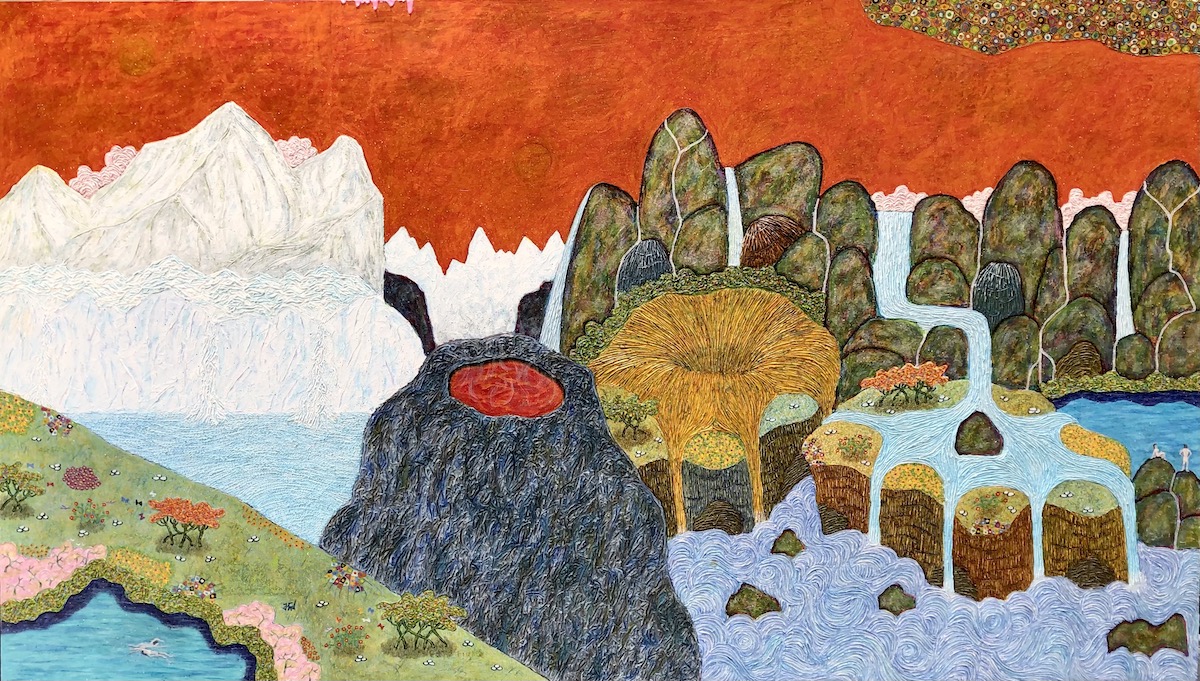“Art is a universal language,” Hung Viet Nguyen says. “And when I came here as an immigrant, my English language was not that great. My strength was in painting. I slowly convinced people that my art is my language.”
Nguyen came to the US from Vietnam in 1982, with a background in biology and a lifelong passion for art. After making the move, he decided to make art his livelihood as well. A course in technical drawing led to a career as an illustrator and graphic artist while raising his children and pursuing his fine art. For seven years he stopped painting to experience nature both in solitude and with his family. “I absorbed the texture and the culture that nature taught me,” he says.
Pattern, color and subject all inform Nguyen’s narrative, spiritual art, the elements of which arise entirely from the artist’s personal experience and interpretation. “Artists balance what happens to them in life with their art,” he says. “When things were all good, sunshine—normal in California—my work was darker for a while, but when the pandemic hit, and it looked so bad, spirits were so down, I made my colors brighter. I wasn’t trying to escape but to balance what my art said with what was happening in the world.”
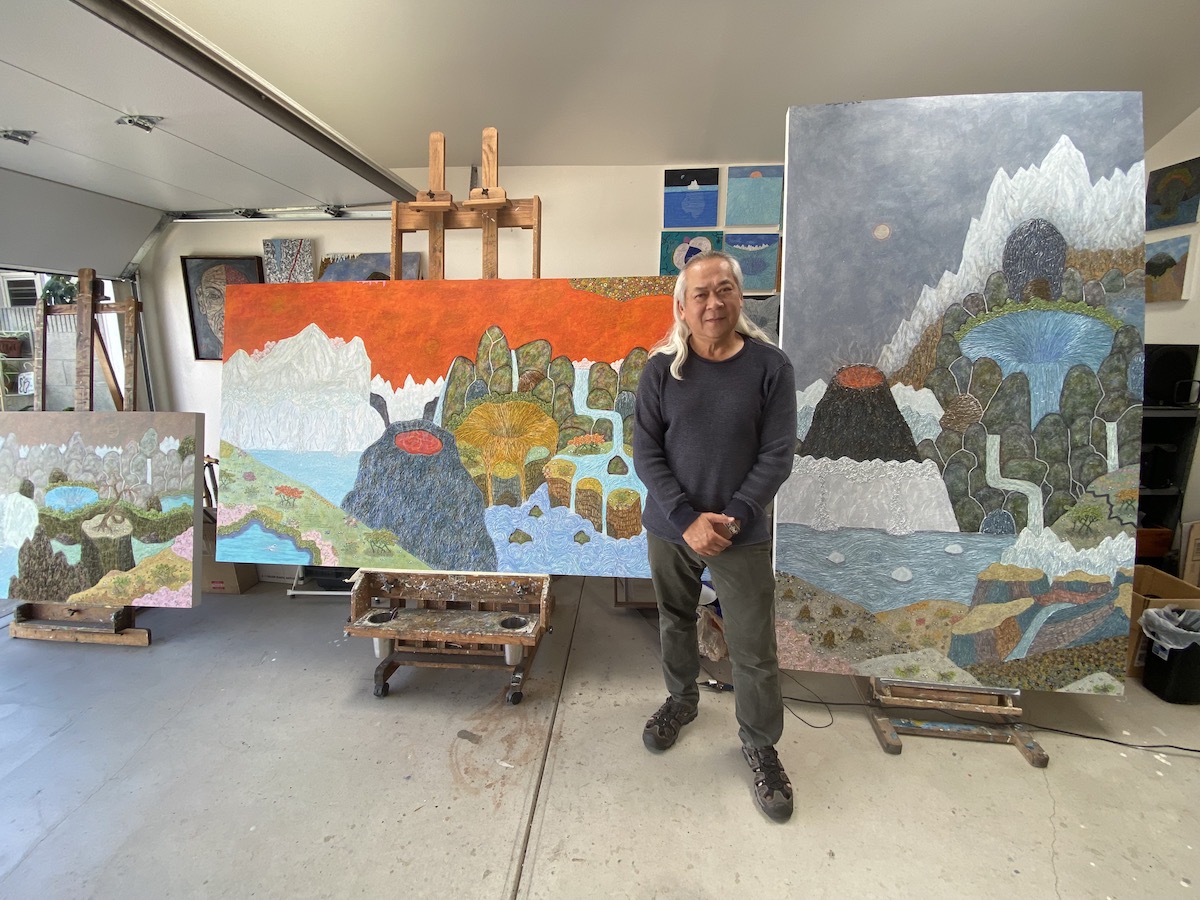
Nguyen in his studio, photo by Genie Davis;
Regardless of the palette Nguyen uses, his work is always spiritual, and devoted to nature, as he himself has been since he was a child. “That is always in my mind from a young age. I had respect for trees, rocks, plants. It’s not religious, it’s spiritual in respect to everything surrounding me—after all, they’ve all been there longer than me.”
Nguyen is currently creating his fifth series of “Sacred Landscapes,” a body of work which average approximately 50 paintings per series. He viewed the cycle of nature through four previous series, titled “Cruelly Go Round;” “Coastal Sensibilities,” which focused on the sea; “Myscape,” referring to his personal landscape; and a more abstract series, “Symphony.”
“What led me to ‘Sacred Landscapes,’ was that we live in a city. I need to live here to work, to sell. But nature is a counterbalance. When I need to, I go to the beach or the trail. I call it going to the temple. Nature to me is closer to God than [I am] in a church.” He often travels the country and abroad to experience nature, with two areas in California most special to him, the Ancient Bristlecone Pine Forest near Bishop, and the Palos Verdes Peninsula near LA.
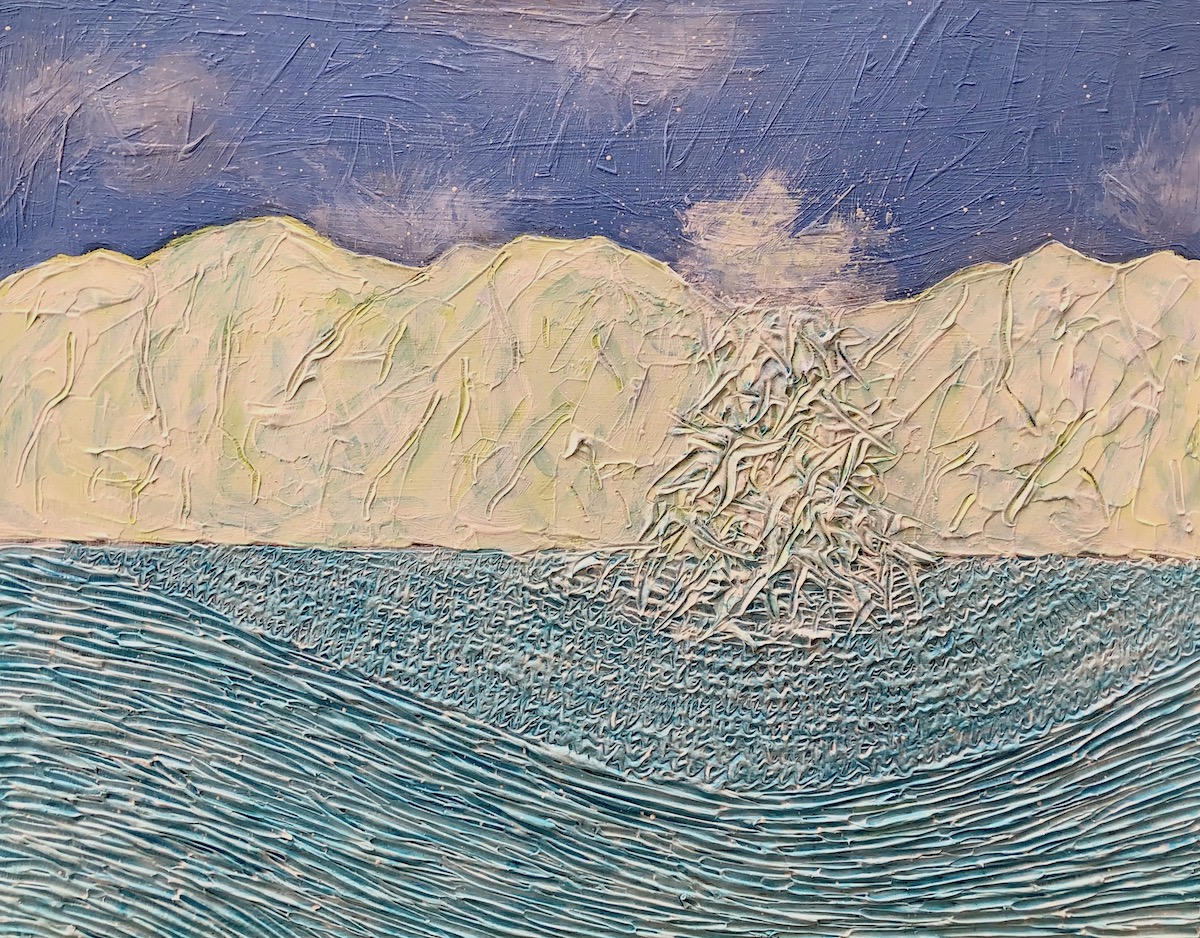
From series, “Sacred Landscape V,” #27, 11” x 14″.
Inspired in part by Asian scroll paintings, highly textured, intricately detailed and visually immersive, Nguyen’s work is created by both palette knife and brush. He runs through so many palette knives that he has collected the used ones on a long chain that hangs from the ceiling of his studio. “I wear out the stainless-steel painting on canvas, that’s how much I use them. But I also use the brush when I want to create something more fluid.” He explains further, “For me the texture comes first, it’s part of my pattern. It can create anything, like a mosaic. When I am out in nature, I look, and I think, I can match that surface, I can recreate that. I think when you have a language, you have an alphabet. And with that alphabet, you can make anything, say anything, good or bad. When I am lucky, I can use my language well, and things like texture turn out as they should, smooth, or soft, or hard.”
Nguyen also sometimes incorporates actual words in his work. On his large-scale (48 x 84 inches) Sacred Landscape V, #32, his wife’s name and mother’s name are partially revealed within the grassy areas of the vast painting. “My wife understands me and lets me have the freedom to create. I also wrote in this piece ‘into nature, open out senses, feeling/seeing, gentle and dangerous magnificent, ask no more, common, extraordinary.’” The work itself is all that. To the left, a clear lake surrounded by a meadow, behind which a glacier rises, slipping into the sea; a steep, vertical volcano with hot lava still seething inside takes up the middle section; another volcano appears to have finished its act of tumultuous creation and adjoins a blissful series of waterfalls, ocean, and another lake around which two small human figures are poised under a rich burnt-orange sky. Both dream and fable, fairy tale and Adam and Eve–Biblical, this work is not just an alphabet of language but an entire novel.
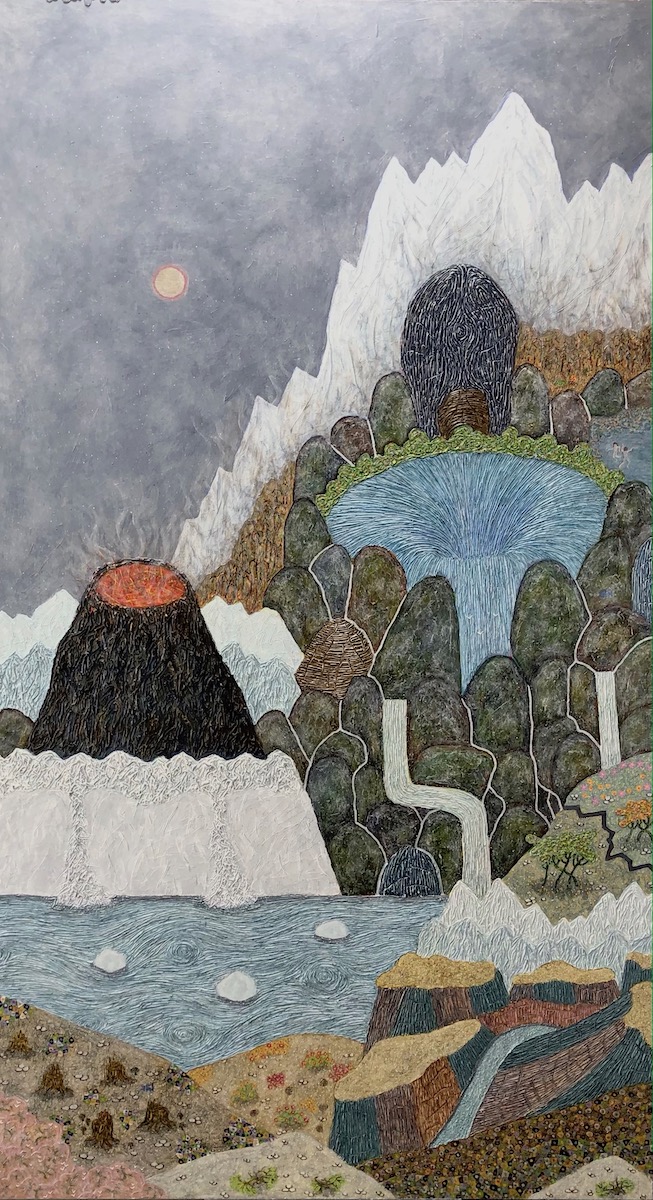
From series, “Sacred Landscape V,” #36, 84” x 48″.
While Nguyen doesn’t specifically see his Vietnamese heritage in his work, he realizes that “my painting looks different than Western painting in some ways,” in that he doesn’t work with perspective. “I create space that isn’t restricting. You can look down or up, as you do when you are in nature.”
Oil on panel, his large vertical work Sacred Landscapes V, #36 features a cavernous volcano, visually twinned with a cascading waterfall spilling into the sea; some smaller panel pieces such as Sacred Landscapes V, #27 feature glacial forms and sea, with the glacier cracking into the ocean; Sacred Landscapes V, #30 is a beautiful, sinuous tree. From an earlier series, Sacred Landscapes IV, #40, gives viewers a dark and transcendent night sky, with a mystical circle suspended above grey hills. In the foreground, a small figure and his horse cross this mysterious landscape.
His subjects in nature are limitless. “Nature taught me my style, which comes from a pattern,” he says. “I am just creating the language; it is a journey of discovery. I think I am going to keep painting for a very long time. I haven’t seen anything that limits me, yet. Sometimes a new element comes up, right now that has been volcanos.”
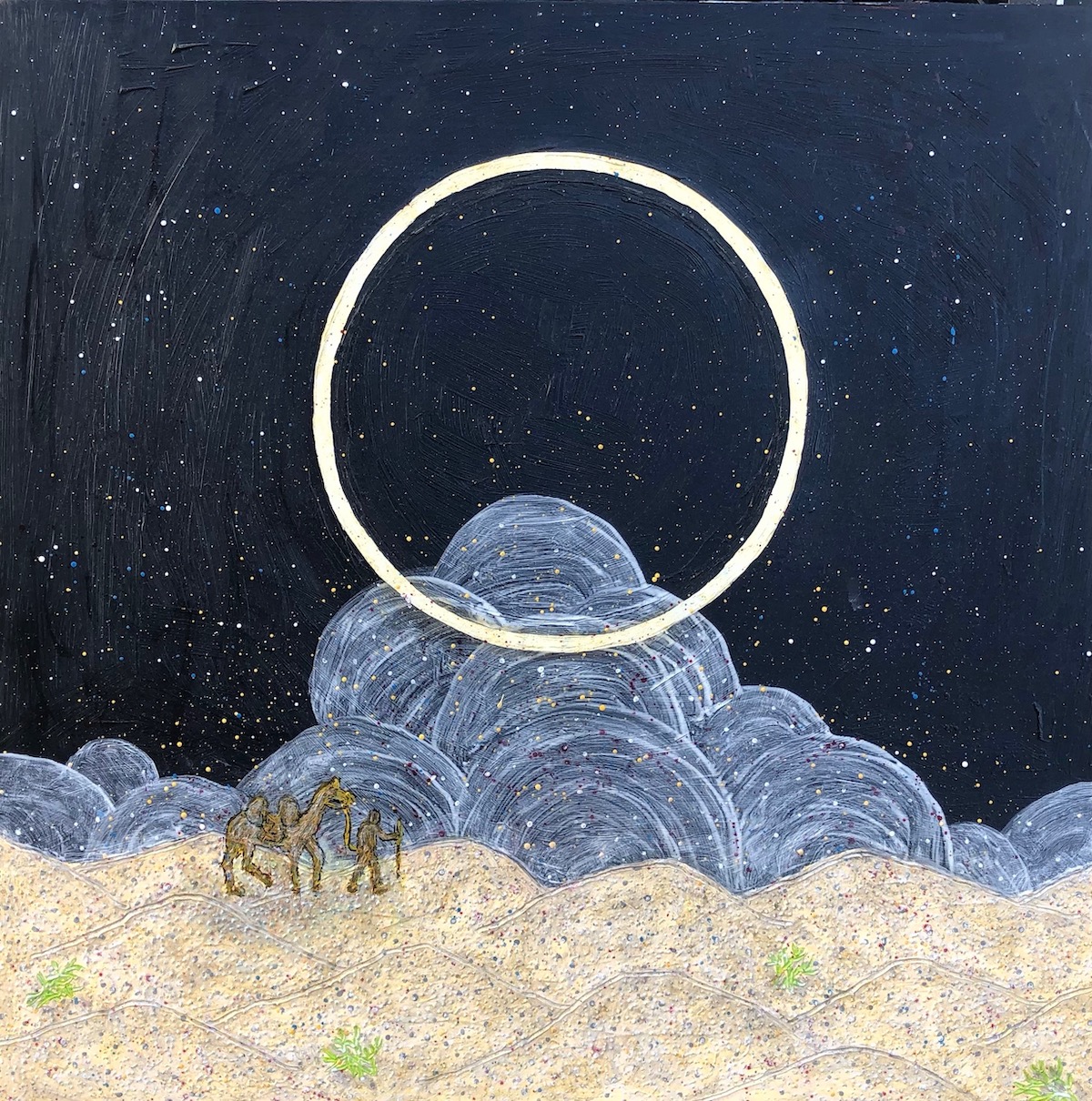
From series, “Sacred Landscape IV,” #40, 12” x 12″.
On days that his studio is too hot or cold, the artist has begun doing smaller pieces in his home, using old product tins such as small metal cigar boxes. He uses both inside panels to create two separate small works that are linked together. In one such piece, Stars Grazing, a couple lie on the grass, looking up on one side. On the opposite side, a filament of stars is strung. To create these he uses pencil, ink, watercolor and varnish. “I use different kinds of varnish—some look old, with a lot of crackle in them. That is something I’m experimenting with.”
Nguyen is prolific and sells approximately 50% of his work. “When you sell, it stimulates you to work harder. Picasso once said he was a good collector of his own work,” he laughs. “It isn’t about selling for me though. I can’t control that. If I work honestly, I satisfy myself, and I believe that if you do honest work, the work will find a way to get out there. If my work is good but no one sees it, they don’t know it is there.”
See Nguyen’s work in March 2022, at the Kleefeld Contemporary Art Museum at California State University Long Beach.

